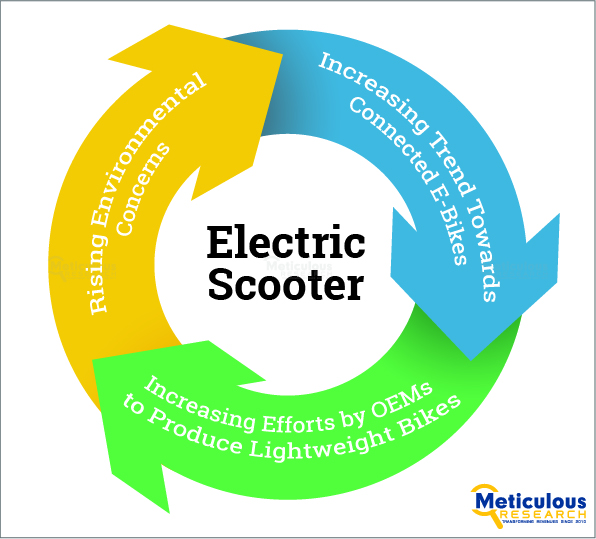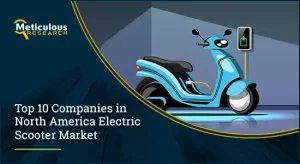
**Electric Scooters: A Growing Mobility Solution**
Electric scooters are plug-in vehicles equipped with two or three wheels, powered by rechargeable batteries that drive one or more electric motors. These scooters typically feature brushless direct current (BLDC) motors integrated into the wheel hubs. This category includes various types of e-bikes, such as kick scooters, electric motorcycles, and electric mopeds.
All electric kick scooters come with at least one motor, while more powerful models may have two. An electric kick scooter consists of a footboard mounted on two wheels and a steering handle, allowing users to propel themselves by pushing off the ground with one foot while the electric motor provides assistance. These scooters serve multiple purposes, including private and public transportation, shared mobility, logistics, and short-distance commuting.
Download Research Report Sample @ https://www.meticulousresearch.com/download-sample-report/cp_id=5239
Electric scooters are increasingly utilized for short-distance travel within urban areas and for courier and e-commerce deliveries. Generally, they have smaller battery packs and a driving range of less than 100 kilometers per charge. Their lightweight design makes them more efficient than traditional bikes, enabling easy maneuverability through congested streets and making them ideal for short commutes.
As traffic congestion leads to longer commute times, more people are seeking convenient and affordable transportation options. Micro-mobility solutions, including bicycles, skateboards, e-bikes, and electric scooters, are becoming popular for short distances. The rise of micro-mobility has also prompted the development of vehicle-sharing alternatives.
In Europe, electric scooters have gained significant traction, especially through sharing schemes similar to bike hire programs. For example, Paris now boasts over 15,000 scooters available for rental. Their popularity is largely due to their lower environmental impact compared to other transport modes. By 2023, electric two-wheelers are projected to account for up to 8% of all two-wheelers on the road, an increase from the current 2.5%. During 2018-2019, the monthly installations of e-scooter sharing apps like Bird and Lime surged by 580%, a trend expected to continue as demand grows. E-scooter revenue is anticipated to rise by 21% by 2023, particularly in Europe and other regions.
### Key Developments in the European Market
Europe has swiftly embraced the e-scooter trend. Notable developments include:
– By 2019, Lime expanded its operations to over 50 European cities, including Paris, London, and Berlin.
– In April 2019, Uber launched its e-scooter service, Uber Jump, in Madrid, rapidly expanding to ten major urban centers within seven months.
Browse in depth @ https://www.meticulousresearch.com/product/europe-electric-scooter-market-5239
The growth of e-scooter and free-floating bike schemes has been remarkable. In 2019, Brussels saw around 3,000 shared e-scooters and bicycles, predominantly used for trips between 2 and 3 kilometers. In Paris, more than 20,000 shared e-scooters are rented daily for weekday commutes, averaging a 19-minute trip.
This surge in shared e-scooter usage is fueled by enhanced internet access, allowing users to rent scooters easily through mobile apps. For instance, in 2020, Bolt Technology OÜ launched an e-scooter ride-sharing system in Bratislava, integrating GPS technology to provide real-time location data for scooters. Currently, Bolt operates a fleet of 200 e-scooters, with plans for expansion as demand increases.
By 2021, several European countries had established ride-sharing e-scooter systems, including Austria, Belgium, Germany, and Sweden. Countries like Denmark have around 7,000 shared e-scooters, while Germany has approximately 50,000. In cities such as Thessaloniki, Greece, and Lisbon, Portugal, the availability of shared e-scooters is growing, promoting wider micro-mobility adoption.
### Regulatory Landscape
To regulate the use of electric bicycles, many European countries have enacted electric vehicle laws. While the use of electric scooters is permitted in countries like Germany and France, regulations vary significantly. In the UK and Ireland, electric scooters are restricted to private land, resulting in penalties for public use.
Sweden has banned motorized scooters exceeding 20 km/h from bicycle lanes, while Paris has imposed fines for riding on pavements and parking in restricted areas. In response, cities are creating dedicated parking spaces for scooters to improve safety and accessibility.
Many European governments are also implementing legislation to meet international climate commitments. As of January 2020, all new motorcycles and mopeds sold in the EU must comply with the Euro 5 environmental standard, which does not apply to electric two-wheelers since they do not produce harmful emissions. The stringent emission regulations are driving the demand for electric scooters across the region, positioning them as a key solution for sustainable urban mobility.
Request Customization Report @ https://www.meticulousresearch.com/request-customization/cp_id=5239







